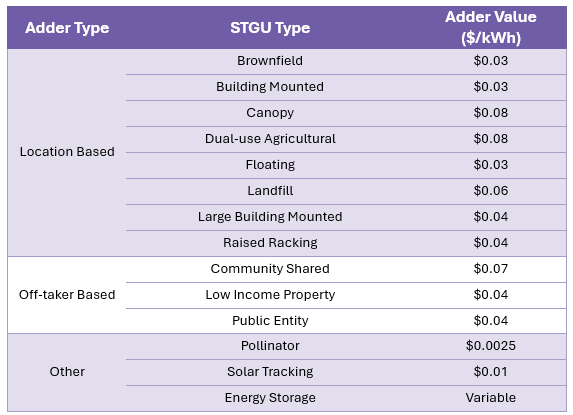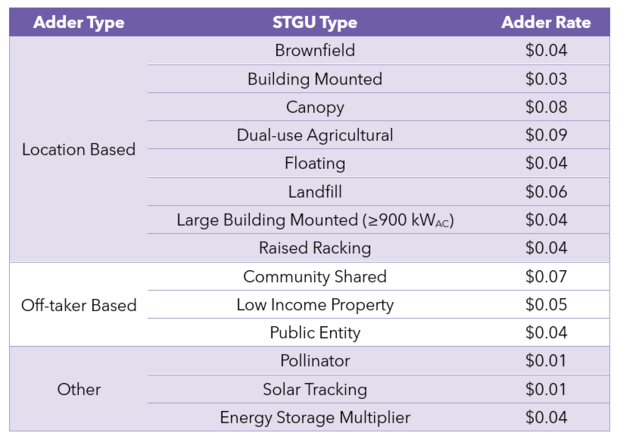How to Apply
Applicants can review the Application and Claim Checklist which details all of the documentation required for small and large applications.
SMART Program Application - National Grid
Program Regulations
On August 28th, 2025, DOER filed final regulations for the SMART 3.0 Program with the Secretary of State's Office, under 225 CMR 28.00. (See summary of program changes.) DOER also made a single redline edit to the existing regulation, 225 CMR 20.00. The revised version of these regulations became effective upon publication in the Massachusetts Register on September 12, 2025.
Tariff Proceeding
On November 21, 2025, The Electric Distribution Companies (EDCs) jointly submitted a filing (25-175) to the Department of Public Utilities (DPU) for review and approval of the proposed SMART 3.0 tariff. The EDCs proposed that the DPU review the filing in phases: (I) non-controversial and clarifying changes to the tariff and (II) additional revisions. The EDCs are not seeking approval of specific costs at this time.
In a December 10 Notice, the DPU announced a virtual public hearing to receive comments on the filing on January 15, 2026 at 2:00pm. They will also collect written comments until January 16 at 5:00pm. Click here for more information on the tariff proceeding and how to submit public comment.
DOER will continue accepting applications and issuing Preliminary Statements of Questions, but the Department will not be issuing Final Statements of Qualification and incentive payments will not begin distribution until the tariff is approved.
Annual Capacity and Rates
Per program regulations, DOER will publish an Annual Report with details on available capacity, set asides, and incentive rates for the applicable Program Year. After the first Program Year, each subsequent Program Year will accept applications from January 1 through December 31 of the applicable year.
Program Year 2025
On August 29th, 2025, DOER published the Program Year 2025 Annual Report. DOER began accepting applications for the first Program Year on October 15, 2025.
Per 225 CMR 28.05(3)(a), Program Year 2025 will have 900 MWAC of available capacity for STGUs subject to the capacity cap.
Program Year 2025 Flat Incentive Rates
Program Year 2025 Base Compensation Rates
Program Year 2025 Adder Rates
Program Year 2025 BTM Value of Energy Workbook
DOER has created a Value of Energy and Incentive Calculator for Behind-the-Meter facilities >25 kW AC. This calculator is intended to be a tool to calculate the Value of Energy and fixed incentive compensation rate for Behind-the-Meter systems. The calculation is based on project type, size, distribution company service territory, and customer rate class. This workbook does not necessarily reflect the final tariff value a system will be qualified for, but is meant to be a tool to estimate the value that a particular customer may receive under different scenarios. This workbook will be in effect through December 31, 2025.
Program Year 2025 BTM Value of Energy Workbook
Program Year 2026
On October 1st, DOER published the Draft Program Year 2026 Annual Report. DOER accepted public comments on the draft report until 5:00 PM on October 31, 2025. The public comments that DOER received on the Draft Annual Report can be found here: Public Comments.
Below are the accompanying files from the Program Year 2026 Annual SMART Program Assessment:
On December 1st, DOER published the Final Program Year 2026 Annual Report and the redlined changes to the draft report. DOER will begin accepting applications for Program Year 2026 on January 1, 2026.
Program Year 2026 Annual Report (redline)
Per the report, Program Year 2026 will have 600 MWAC of available capacityfor STGUs subject to the capacity cap.
Program Year 2026 Flat Incentive Rates
Program Year 2026 Base Compensation Rates
Program Year 2026 Adder Rates
Program Year 2026 BTM Value of Energy Workbook
DOER has created a Value of Energy and Incentive Calculator for Behind-the-Meter facilities >25 kW AC. This calculator is intended to be a tool to calculate the Value of Energy and fixed incentive compensation rate for Behind-the-Meter systems. The calculation is based on project type, size, distribution company service territory, and customer rate class. This workbook does not necessarily reflect the final tariff value a system will be qualified for, but is meant to be a tool to estimate the value that a particular customer may receive under different scenarios. This workbook will be in effect through December 31, 2026.
Program Guidelines
Below are the final guidelines and materials for SMART 3.0, following the public comment period. Materials will be posted here on a rolling basis.
- Guideline on Base Compensation Rates, Compensation Rate Adders, and Annual Assessment
- Guideline on Energy Storage
- Guideline Regarding Community Shared Solar Tariff Generation Units (redline edits)
- Guideline Regarding Low Income Generation Units (redline edits)
- Statement of Qualification Reservation Period Guideline (redline edits)
- Guideline Regarding the Definition of Floating Solar Tariff Generation Units
- Customer Disclosure Forms:
- Energy Storage Adder Calculators:
- Miscellaneous:
*Projects in SMART 2.0 will still be subject to the Program Guidelines established for SMART 2.0, which can be found on the respective program page: SMART 1.0 & 2.0 Program Details.
Draft Program Guidelines
DOER posted draft guidelines and materials for SMART 3.0 here on a rolling basis. Drafts were available for public comment for 21 calendar days after the posted date.
Comments should be submitted as a PDF file to DOER.SMART@mass.gov with the email subject line “SMART 3.0 [Guideline Title] Public Comment.”
- Guideline Regarding the Definition of Brownfield - posted 12/5/25
- Guideline Regarding the Definition of Dual-use Agricultural STGUs - posted 09/24/25
- Guideline Regarding Land Use, Siting, and Project Segmentation - posted 09/24/25
- Guideline on Consumer Protection - posted 09/24/25
- Miscellaneous:
- Dual-use Agricultural STGU Pre-Determination Form - posted 09/24/25
- Dual-use Agricultural STGU Annual Report Template - posted 10/09/25
Requests for Extensions and Exceptions
Information on how to submit a request for an exception or an extension under the SMART Program can be found on the Requests for Extensions and Exceptions page.
Program Compliance and Audits
Each year, the Department undertakes compliance checks to ensure that program participants are remaining in compliance with the SMART regulations and guidelines. More detailed information can be found on the SMART Compliance Reports and Audits page.





